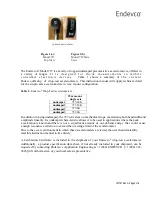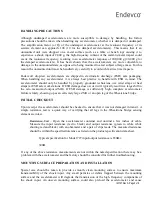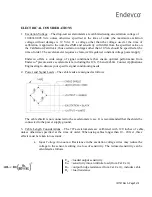
IM727 Rev A, Page 8 of 9
®
Nyquist frequency). Once digitized, the aliased frequencies will fold back over the Nyquist
frequency into the frequency range of interest resulting in errors in the data. To prevent aliasing, the
sampling rate should be at least two times (and preferably ten times) the highest frequency present.
The highest frequency present in almost all situations will be the resonant frequency of the high
shock accelerometer. Better yet, an analog anti-aliasing filter should be placed before
digitization with a cutoff frequency of at least one-half (and preferably one-tenth) the sampling
rate. The anti-aliasing filter safeguards against any unpredictable out-of-band energy and is the
most reliable approach to acquiring good quality, non-aliased data.
See Endevco Technical Paper TP284 for further information on high-frequency, high-level testing
and calibration.
REMOVAL OF THE ACCELEROMETER
To remove the 727 accelerometer from your application, please use the supplied removal tool,
Endevco® part number 42894. The tool should be placed over the accelerometer with the cable
positioned away from the tool to shear the accelerometer off the surface of your application by
gently wriggling the tool in clockwise and counterclockwise directions.
CLEANING
If desired, dirty accelerometers may be wiped clean using a damp cloth and a solvent such as
acetone.
Do not soak or immerse
the unit in any solvent or water. Do not use any sharp tool such
as a screwdriver to remove dirt or contaminants. Any temporary adhesives, such as wax or
cyanoacrylate, used to mount the accelerometer, should be cleaned with an appropriate solvent (such
as acetone).
RECALIBRATION
As with any measuring device, optimum accuracy is maintained by periodic recalibration.
Sensitivity and ZMO calibration should be performed at 6 to 12 month intervals depending on usage.
Ordinarily, recalibration need only be performed at 12 month intervals if it is known that the
accelerometer has not been used beyond its rated specifications. If the unit is used under severe
environments, it may be desirable to use shorter calibration intervals. When testing at high levels
(levels exceeding the accelerometer’s full-scale range) it is recommended that calibration be
performed every six months or after each high-amplitude test.
The general health of the accelerometer can be assessed by measuring the ZMO and comparing the
value to the most recent calibration certificate. The ZMO can be checked by applying a well-
regulated excitation voltage (10 Vdc in most cases, unless otherwise specified at time of order) to
the red-black leads and reading out the differential voltage between the green-white leads. Changes
in ZMO of up to ±20mV with time and usage are not uncommon and are not necessarily a sign of a
damaged accelerometer. Changes of greater than ±20mV may indicate damage to the sensor and the









